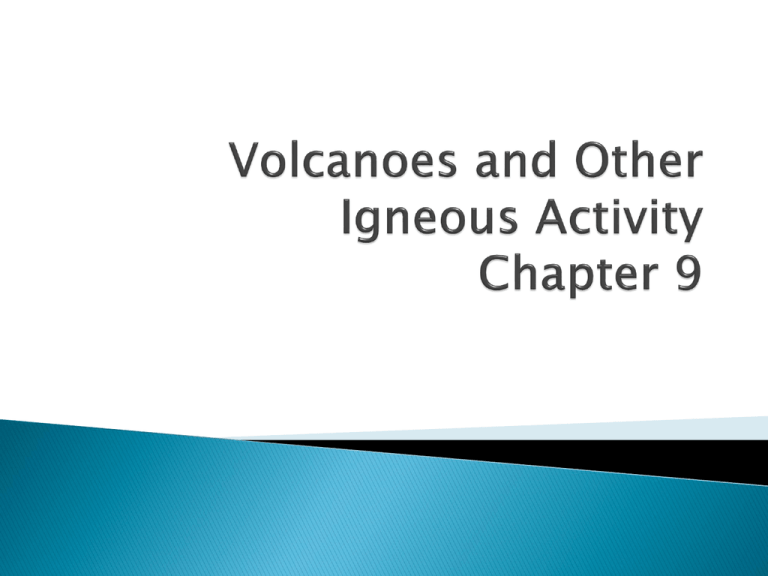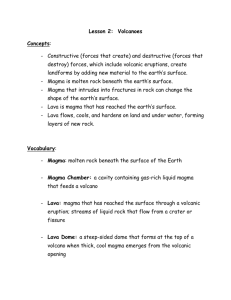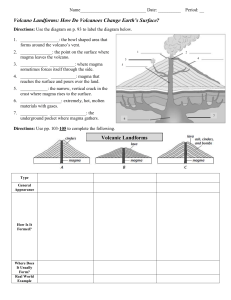Volcanoes and Igneous Activity Earth
advertisement

Factors that determine the violence of an eruption ◦ Composition of the magma ◦ Temperature of the magma ◦ Dissolved gases in the magma Viscosity of magma ◦ Viscosity is a measure of a material’s resistance to flow Viscosity of magma ◦ Factors affecting viscosity Temperature (hotter magmas are less viscous) Composition (silica content) High silica – high viscosity (e.g., rhyolitic lava) Low silica – more fluid (e.g., basaltic lava) Dissolved gases (volatiles) Mainly water vapor and carbon dioxide Gases expand near the surface Viscosity of magma ◦ Factors affecting viscosity Dissolved gases (volatiles) Provide the force to extrude lava Violence of an eruption is related to how easily gases escape from magma Easy escape from fluid magma Viscous magma produces a more violent eruption Lava flows ◦ Basaltic lavas are more fluid ◦ Types of lava Pahoehoe lava (resembles braids in ropes) Aa lava (rough, jagged blocks) Gases ◦ One to five percent of magma by weight ◦ Mainly water vapor and carbon dioxide Pyroclastic materials ◦ “Fire fragments” ◦ Types of pyroclastic material Ash and dust – fine, glassy fragments Pumice – from “frothy” lava Lapilli – “walnut” size Cinders – “pea-sized” Particles larger than lapilli Blocks – hardened lava Bombs – ejected as hot lava General features ◦ Conduit, or pipe, carries gas-rich magma to the surface ◦ Vent, the surface opening (connected to the magma chamber via a pipe) ◦ Crater Steep-walled depression at the summit Caldera (a summit depression greater than 1 km diameter) General features ◦ Parasitic cones ◦ Fumaroles Types of volcanoes ◦ Shield volcano Broad, slightly domed Primarily made of basaltic (fluid) lava Generally large size e.g., Mauna Loa in Hawaii Types of volcanoes ◦ Cinder cone Built from ejected lava fragments Steep slope angle Rather small size Frequently occur in groups Types of volcanoes ◦ Composite cone (or stratovolcano) Most are adjacent to the Pacific Ocean (e.g., Mt. Rainier) Large size Interbedded lavas and pyroclastics Most violent type of activity Types of volcanoes ◦ Composite cone (or stratovolcano) Often produce nuée ardente Fiery pyroclastic flow made of hot gases infused with ash Flows down sides of a volcano at speeds up to 200 km (125 miles) per hour May produce a lahar – volcanic mudflow Calderas ◦ ◦ ◦ ◦ Steep walled depression at the summit Formed by collapse Nearly circular Size exceeds one kilometer in diameter Fissure eruptions and lava plateaus ◦ Fluid basaltic lava extruded from crustal fractures called fissures ◦ e.g., Columbia Plateau Volcanic pipes and necks ◦ Pipes are short conduits that connect a magma chamber to the surface ◦ Volcanic necks (e.g., Shiprock, New Mexico) are resistant vents left standing after erosion has removed the volcanic cone Most magma is emplaced at depth An underground igneous body is called a pluton Plutons are classified according to ◦ Shape Tabular (sheet-like) Massive Plutons are classified according to ◦ Orientation with respect to the host (surrounding) rock Discordant – cuts across existing structures Concordant – parallel to features such as sedimentary strata Types of igneous intrusive features ◦ Dike, a tabular, discordant pluton ◦ Sill, a tabular, concordant pluton e.g., Palisades Sill, NY Resemble buried lava flows May exhibit columnar joints ◦ Laccolith Similar to a sill Types of igneous intrusive features ◦ Laccolith Lens shaped mass Arches overlying strata upward ◦ Batholith Largest intrusive body Often occur in groups Surface exposure 100+ square kilometers (smaller bodies are termed stocks) Frequently form the cores of mountains Magma originates when essentially solid rock, located in the crust and upper mantle, melts Factors that influence the generation of magma from solid rock ◦ Role of heat Earth’s natural temperature increases with depth (geothermal gradient) is not sufficient to melt rock at the lower crust and upper mantle Factors that influence the generation of magma from solid rock ◦ Role of heat Additional heat is generated by Friction in subduction zones Crustal rocks heated during subduction Rising, hot mantle rocks Factors that influence the generation of magma from solid rock ◦ Role of pressure Increase in confining pressure causes an increase in melting temperature Drop in confining pressure can cause decompression melting Lowers the melting temperature Occurs when rock ascends Factors that influence the generation of magma from solid rock ◦ Role of volatiles Primarily water Cause rock to melt at a lower temperature Play an important role in subducting ocean plates Factors that influence the generation of magma from solid rock ◦ Partial melting Igneous rocks are mixtures of minerals Melting occurs over a range of temperatures Produces a magma with a higher silica content than the original rock Global distribution of igneous activity is not random ◦ Most volcanoes are located on the margins of the ocean basins (intermediate, andesitic composition) ◦ Second group is confined to the deep ocean basins (basaltic lavas) ◦ Third group includes those found in the interiors of continents Plate motions provide the mechanism by which mantle rocks melt to form magma ◦ Convergent plate boundaries Descending plate partially melts Magma slowly rises upward Rising magma can form Volcanic island arcs in an ocean (Aleutian Islands) Continental volcanic arcs (Andes Mountains) Plate motions provide the mechanism by which mantle rocks melt to form magma ◦ Divergent plate boundaries The greatest volume of volcanic rock is produced along the oceanic ridge system Lithosphere pulls apart Less pressure on underlying rocks Partial melting occurs Large quantities of fluid basaltic magma are produced Plate motions provide the mechanism by which mantle rocks melt to form magma ◦ Intraplate igneous activity Activity within a rigid plate Plumes of hot mantle material rise Form localized volcanic regions called hot spots Examples include the Hawaiian Islands and the Columbia River Plateau in the northwestern United States






